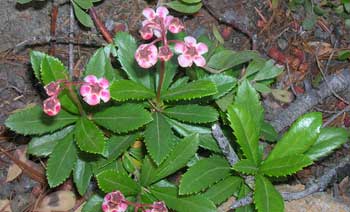Contents:
Common Names | Parts Usually Used | Plant(s) & Culture | Where Found | Medicinal Properties | Biochemical Information
Uses | Formulas or Dosages | Warning | Bibliography
Scientific Names

- Chimaphila umbellata L.
- Pyrolaceae
- Heath family
Common Names
- Bitter wintergreen
- False wintergreen
- Ground holly
- King’s cure
- Prince’s pine
- Rheumatism weed
Parts Usually Used
The entire plant
Back to Top
Description of Plant(s) and Culture
Pipsissewa is a perennial; 6-12 inches; a small half-shrubby, evergreen plant; a creeping, white rootstock produces several angular stems growing to about a foot high. The leathery, bright green leaves, 2-3 inches long, thick and shiny and toothed, grow in whorls and are oblanceolate to oblong with sharply serrate margins. Terminal corymbs of nodding, waxy, white or pinkish, fragrant flowers with purple centers, with 5 petals and a ring of red anthers, rise above the leaves in a cluster of 4-7 blossoms; appear from May to August. The fruit is an erect 5-celled capsule.
Back to Top
Where Found
Grows in dry woods (acid soil rich in leaf mold) of the northern temperate areas of the world. It is found everywhere in the United States and southern Canada, in the mountains in the south. Absent from the southeastern and central southern states.
Back to Top
Medicinal Properties
Alterative, astringent, diaphoretic, diuretic, laxative, tonic
Back to Top
Biochemical Information
The glycosides arbutin, ericolin and chimophilin, excreted in the urine as disinfectant substances similar to uva ursi, sitosterol, ursolic acid
Back to Top
Uses
Noted for producing diuretic action without irritant side-effects. Prolonged use of the leaf tea is said to dissolve bladder stones and dropsy. It has been recommended for scrofula and rheumatic problems. With medical supervision, it can be used for dropsy, albuminuria, hematuria, chronic kidney problems, and gonorrhea. Externally, a tea or poultice made from the plant can be applied to ulcers, sores, tumors, blisters, and swellings, muscle cramps.
Native Americans used leaf tea for backaches, coughs, stomachaches, as a blood purifier, diuretic; drops used for sore eyes. Leaves were smoked as a tobacco substitute.
Back to Top
Formulas or Dosages
Use leafy part of plant, fresh or dried.
Infusion: steep 1 tsp. leaves (or plant) in 1/2 cup water. Take in the course of a day, a mouthful at a time, unsweetened.
Tincture: take 2 to 15 drops, as needed. Follow the directions on the bottle.
Old timers made a beer of pipsissewa for medicinal use.
Back to Top
Warning
Leaves poulticed on the skin may induce redness, blisters, and peeling. Arbutin hydrolyzes to the toxic urinary antiseptic hydroquinone.
Back to Top
Bibliography
![]() The Herb Book
The Herb Book, by John Lust, Bantam Books, 666 Fifth Avenue, New York, NY. copyright 1974.
![]() Back to Eden
Back to Eden, by Jethro Kloss; Back to Eden Publishing Co., Loma Linda, CA 92354, Original copyright 1939, revised edition 1994
![]() The Herbalist Almanac
The Herbalist Almanac, by Clarence Meyer, Meyerbooks, publisher, PO Box 427, Glenwood, Illinois 60425, copyright 1988, fifth printing, 1994
![]() Eastern/Central Medicinal Plants
Eastern/Central Medicinal Plants, by Steven Foster and James A. Duke., Houghton Mifflin Company, 215 Park Avenue South, New York, NY 10000
![]() Planetary Herbology
Planetary Herbology, by Michael Tierra, C.A., N.D., O.M.D., Lotus Press, PO Box 325, Twin Lakes. WI 53181., Copyright 1988, published 1992
![]() Indian Herbalogy of North America
Indian Herbalogy of North America, by Alma R. Hutchens, Shambala Publications, Inc., Horticultural Hall, 300 Massachusetts Avenue, Boston, Massachusetts 02115, 1973
![]() American Folk Medicine
American Folk Medicine, by Clarence Meyer, Meyerbooks, publisher, PO Box 427, Glenwood, Illinois 60425, 1973
![]() Webster’s New World Dictionary
Webster’s New World Dictionary, Third College Edition, Victoria Neufeldt, Editor in Chief, New World Dictionaries: A Division of Simon & Schuster, Inc., 15 Columbus Circle, New York, NY 10023
 How Indians Use Wild Plants for Food, Medicine & Crafts
How Indians Use Wild Plants for Food, Medicine & Crafts, by Frances Densmore, Dover Publications, Inc., 180 Varick Street, New York, NY 10014, first printed by the United States Government Printing Office, Washington, in 1928, this Dover edition 1974
 An Instant Guide to Medicinal Plants
An Instant Guide to Medicinal Plants, by Pamela Forey and Ruth Lindsay, Crescent Books (January 27, 1992).
![]() The Yoga of Herbs: An Ayurvedic Guide to Herbal Medicine
The Yoga of Herbs: An Ayurvedic Guide to Herbal Medicine, by Dr. David Frawley & Dr. Vasant Lad, Lotus Press, Twin Lakes, Wisconsin, Second edition, 1988.
 The Rodale Herb Book: How to Use, Grow, and Buy Nature’s Miracle Plants (An Organic gardening and farming book)
The Rodale Herb Book: How to Use, Grow, and Buy Nature’s Miracle Plants (An Organic gardening and farming book), edited by William H. Hylton, Rodale Press, Inc. Emmaus, PA, 18049., 1974
